Tips & Tricks: Eclipse Contouring
We want to share a few of our contouring tips and tricks that our team developed in the clinic.
We wanted to share a few of our evaluation tips and tricks we developed in the clinic.
How much time do you spend evaluating conformity and dose spill constraints in SBRT/SRS plans? Most likely longer than you would like. While it may feel like a tedious process at times, it is an extremely important step in the planning process.
Recognizing how important and time consuming evaluating conformity and dose spill can be, we wanted to share a few of our evaluation tips and tricks we developed in the clinic. Do you have any other tips or tricks that you always use? Let us know what you find to be most helpful in the clinic!
Contents:
Conformity Index
Gradient Index/Paddick Conformity Index
Dose Spill Outside of the PTV
Issues with Converting Isodoses to Structures
ClearCheck
Additional Resources
Additional Resources
Conformity Index is an important metric for determining how tightly the prescription dose is conforming to the target. The ICRU report 62 defines conformity index as CI = TV/PTV where TV is the treated volume enclosed by a given isodose surface (e.g. 100%, 50%) and PTV is the planning target volume.
The volume of a given isodose level is the volume of dose inside the “BODY” structure on the DVH. Since the BODY structure bounds the calculated dose to within its limits, this allows you to identify the total volume of a given isodose in the patient. *Note be careful to make sure the 3D calculation volume does not cut off the dose you are evaluating as the results will be incorrect.
The isodose volume from the DVH can then be divided by the PTV volume to determine the CI. In this case, when evaluating the 100% isodose we calculate CI =12.9232cc/11.56cc= 1.12
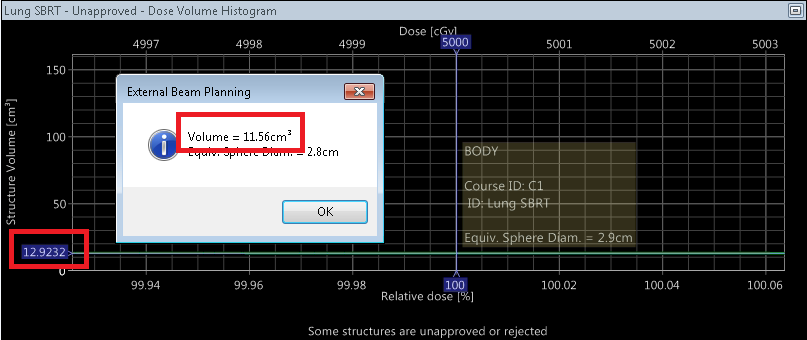
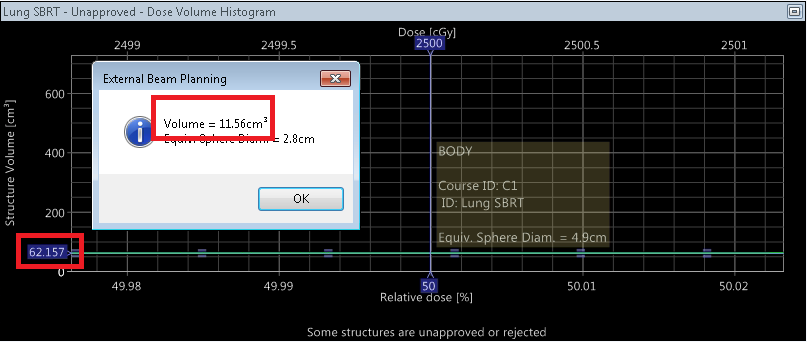

Other conformity measurements can be calculated in a similar manner as above by evaluating isodose volumes on the DVH of the BODY structure or of the PTV to determine their volumes. This is useful for both the Paddick Conformity Index and Gradient Index.
Paddick Conformity Index: PCI = (TVPIV)²/TV*PIV where TVPIV is the target volume covered by the prescription isodose volume, TV is the Target Volume, and PIV is the prescription isodose volume.
Gradient Index: GI = PIVhalf/PIV where PIVhalf is the prescription isodose volume, at half the prescription isodose and PIV is the prescription isodose volume.
Dose spill outside of the PTV is also an important metric for determining how tightly the dose is conforming to the target. Evaluating the dose spill of the 105% isodose volume outside of the PTV can also be done by identifying volumes on the DVH.
The BODY structure can be used to determine the volume of the 105% isodose. The difference between the BODY V105% and the PTV V105% evaluated on the DVH will result in the volume of 105% outside of the PTV. Since the BODY will contain the PTV structure, looking up the 105% on the BODY will contain all of the 105% in the patient (which includes the amount inside the PTV). Then it is a matter of subtracting the 105% inside the PTV (determined by looking up the 105% on the DVH PTV structure) to determine the volume of 105% outside the PTV.
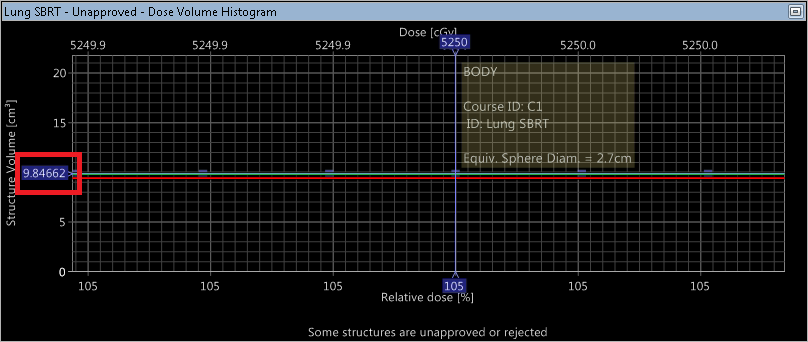
Volume of 105% in the Body = 9.84662cc
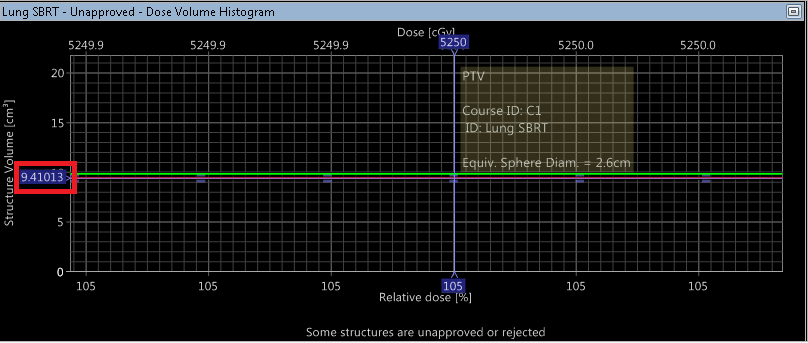
Volume of 105% spilling outside the PTV = 9.84662-9.41013 = 0.43649cc
A common technique is to convert an isodose to a structure. Though this can be used to determine a conformity value or dose spill, depending on the volume of the structure the accuracy can vary. This technique will underestimate the structure volume of the converted isodose do to the limited accuracy in creating the structure. When converting the isodose to a structure, the resulting structure is created as a normal resolution structure. Normal structures in Eclipse have their voxels binned 2×2 leading to a loss of resolution (vs a high resolution structure which is binned 1×1). If the volume of the structure is small or boolean subtraction is being done (e.g. subtract 105% isodose volume structure from the PTV structure) the low-resolution structure can lead to errors in calculating conformity or dose spill.
Shown below, the 105% was converted to an isodose volume and then a boolean subtraction was done from the PTV. The magenta is the boolean subtraction result and you can see how the reduced resolution led to a lower volume than expected. In this case, we expected our volume of 105% outside of the PTV to be 0.43649cc and instead it’s reporting 0cc. You can see in the image how the Magenta does not overlap with the red dose color wash which is the 105%
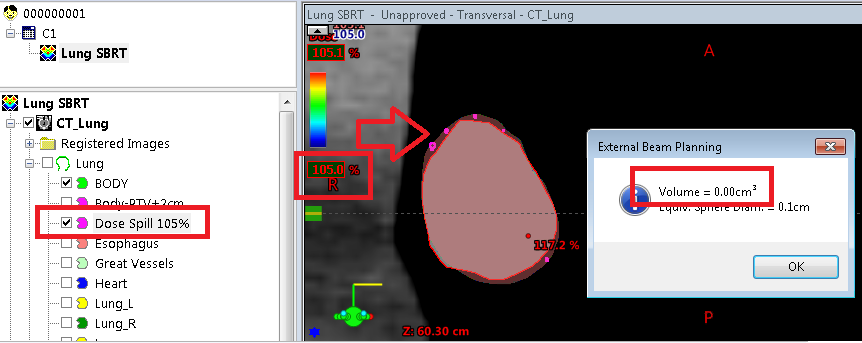
Converting isodose levels at varying dose grid sizes will show similar results where the isodose conversion to a structure always reports lower than looking at the 105% volume on the DVH. In the example below the difference is ~3% when compared to the volume of the PTV. *Note the dose grid size will also affect the volume you measure with both the DVH and convert isodose to structure methods.
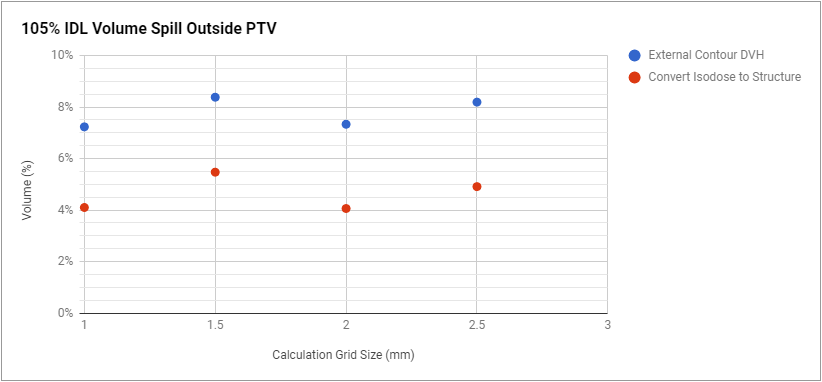
The fastest way to calculate CI, GI, PCI, and Dose Spill is to run ClearCheck. ClearCheck comes pre-loaded with RTOG protocols and allows you to easily customize constraints for your department. ClearCheck will automatically calculate these constraints and interpolate any goal values needed based on your PTV volume.
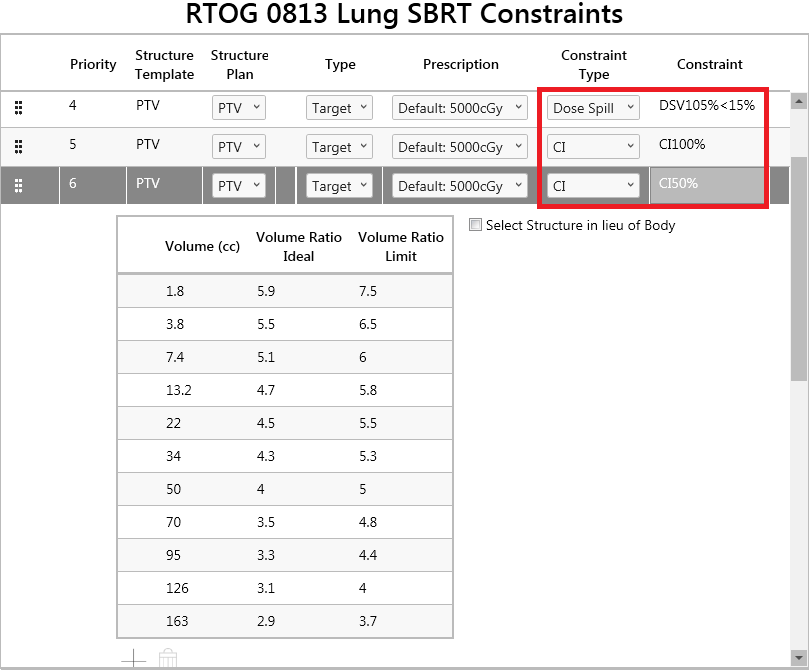
Once the template is added to the patient, you will instantly see results for your dose constraints.
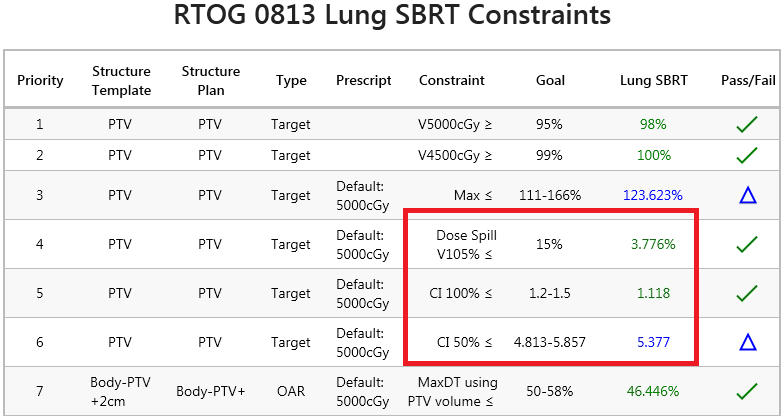

Tyler is a board-certified medical physicist with extensive clinical experience in radiation therapy. He is active in the medphys community including several AAPM committees, the AAPM Board of Directors, and as an ABR orals examiner. Tyler dabbles in real estate investing, loves preparing breakfast for his three kiddos, and enjoys playing adult coed soccer.
Related tags: Treatment Planning Tips & Tricks
We want to share a few of our contouring tips and tricks that our team developed in the clinic.
TG-101 report addendum makes modifications to key dose constraints for three-fraction SBRT
ClearCheck reporting in compliance with ACR standards.
Leave a comment